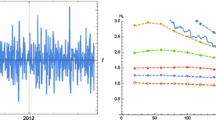Abstract
This paper presents a Monte-Carlo study on the practical reliability of numerical algorithms for FIML-estimation in nonlinear econometric models. The performance of different techniques of Hessian approximation in trust-region algorithms is compared regarding their “robustness” against “bad” starting points and their “global” and “local” convergence speed, i.e. the gain in the objective function, caused by individual iteration steps far off from and near to the optimum.
Concerning robustness and global convergence speed the crude GLS-type Hessian approximations performed best, efficiently exploiting the special structure of the likelihood function. But, concerning local speed, general purpose techniques were strongly superior. So, some appropriate mixtures of these two types of approximations turned out to be the only techniques to be recommended.
Zusammenfassung
Diese Arbeit beschreibt eine Monte-Carlo-Studie über die praktische Verläßlichkeit numerischer Algorithmen zur FIML-Schätzung in nichtlinearen ökonometrischen Modellen. Dabei wird die Güte verschiedener Hessematrixnäherungen in trust-region Algorithmen vergleichen hinsichtlich der “Robustheit” gegenüber “schlechten” Starwerten und hinsichtlich “globaler” und “lokaler” Konvergenzgeschwindigkeit, d. h. der Größe der Verbesserung der Zielfunktion bei Iterationsschritten weit entfernt bzw. in der Nähe vom Optimum.
Während sich GLS-Typ Näherungen der Hessematrix hinsichtlich Robustheit und globaler Konvergenz als deutlich überlegen erweisen wegen ihrer effizienten Ausnutzung der speziellen Struktur der Likelihood-Funktion, konvergieren Verfahren, die für allgemeine Zielfunktionen entwicklet wurden, wesentlich schneller in der Nähe des Optimums. Für die praktische Anwendung erweisen sich daher lediglich geeignete “Mischungen” dieser beiden Näherungstypen als empfehlenswert.
Similar content being viewed by others
References
Amemiya, T.: The maximum likelihood and the nonlinear three-stage least squares estimator in the general nonlinear simultaneous equation model. Econometrica45, 955–968 (1977).
Belsley, D. A.: On the computational competitiveness of full-information maximum-likelihood and three-stage least-squares in the estimation of nonlinear simultaneous-equation models. Journal of Econometrics9, 315–342 (1979).
Belsley, D. A.: On the efficient computation of the nonlinear full-information maximum-likelihood estimator. Journal of Econometrics14, 203–225 (1980).
Berndt, E. K., Hall, B. H., Hall, R. E., Hausman, J. A.: Estimation and inference in nonlinear structural models. Annals of Economic and Social Measurement3, 653–665 (1974).
Calzolari, G., Panattoni, L.: A simulation study on FIML covariance matrix. Pisa: Centro Scientifico IBM, paper presented at the European Meeting of the Econometric Society, Madrid, September 3–7 (1984).
Calzolari, G., Panattoni, L.: Gradient methods in FIML estimation of econometric models. Pisa: Centro Scientifico IBM, paper presented at the International Conference on Economic Policies and Control Theory, Venezia, January 29–February 1 (1985).
Calzolari, G., Panattoni, L., Weihs, C.: Computational efficiency of FIML estimation. Pisa: Centro Scientifico IBM, mimeo (1985).
Dagnais, M. G.: The computation of FIML-estimates as iterative generalized least-squares estimates in linear and nonlinear simultaneous equation models. Econometrica46, 1351–1362 (1978).
Dennis, J. E. Jr., Moré, J. J.: Quasi-Newton methods, motivation and theory. SIAM Review19, 46–89 (1977).
Moré, J. J.: Recent developments in algorithms and software for trust-region methods. In: Mathematical Programming, The State of the Art, Bonn 1982 (Bachem, A., Groetschel, M., Korte, B., eds.), pp. 258–287. Springer-Verlag 1983.
Parke, W. R.: An algorithm for FIML and 3SLS estimation of large nonlinear models. Econometrica50, 81–95 (1982).
Powell, M. J. D.: Convergence properties of a class of minimization algorithms. In: Nonlinear Programming 2 (Mangasarian, O. L., Meyer, R. R., Robinson, S. M., eds.), pp. 1–27. Academic Press 1975.
Theil, H.: Principles of Econometrics. J. Wiley 1971.
Weihs, C.: IAS-System Bonn, User's Manual. University of Bonn, Wirtschaftstheoretische Abt. I, discussion paper No. 144a (1984).
Weihs, C.: Convergence of an algorithm for FIML-estimation in (non-)linear econometric models. In: Methods of Operations Research 49 (Brucker, P., Pauly, R., eds.), pp. 101–126. Verlag A. Hain 1985.
Weihs, C.: Auswirkungen von Fehlern in den Daten auf Parameterschätzungen und Prognosen (Effects of data errors on parameter estimates and forecasts). Dissertation, University of Trier (FRG) (to appear) (1987).
Author information
Authors and Affiliations
Additional information
This work was mainly carried out during a research visit of C. Weihs at the Scientific Center of IBM Italia in Pisa.
Rights and permissions
About this article
Cite this article
Weihs, C., Calzolari, G. & Panattoni, L. The behavior of trust-region methods in FIML-estimation. Computing 38, 89–100 (1987). https://doi.org/10.1007/BF02240175
Received:
Issue Date:
DOI: https://doi.org/10.1007/BF02240175




